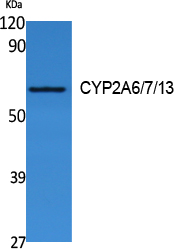
| WB | 咨询技术 | Human,Mouse,Rat |
| IF | 咨询技术 | Human,Mouse,Rat |
| IHC | 咨询技术 | Human,Mouse,Rat |
| ICC | 技术咨询 | Human,Mouse,Rat |
| FCM | 咨询技术 | Human,Mouse,Rat |
| Elisa | 1/10000 | Human,Mouse,Rat |
| Aliases | CYP2A6; CYP2A3; Cytochrome P450 2A6; 1; 4-cineole 2-exo-monooxygenase; CYPIIA6; Coumarin 7-hydroxylase; Cytochrome P450 IIA3; Cytochrome P450(I); CYP2A7; Cytochrome P450 2A7; CYPIIA7; Cytochrome P450 IIA4; CYP2A13; Cytochrome P450 2A13; CYPIIA13 |
| Entrez GeneID | 1548/1549/1553 |
| WB Predicted band size | Calculated MW: 56 kDa; Observed MW: 56 kDa |
| Host/Isotype | Rabbit IgG |
| Antibody Type | Primary antibody |
| Storage | Store at 4°C short term. Aliquot and store at -20°C long term. Avoid freeze/thaw cycles. |
| Species Reactivity | Human |
| Immunogen | Synthesized peptide derived from the Internal region of human CYP2A6/7/13. |
| Formulation | Purified antibody in PBS with 0.05% sodium azide,0.5%BSA and 50% glycerol. |
+ +
以下是关于Cytochrome P450 2A6/7/13抗体的3篇参考文献及其摘要概括:
1. **"Selectivity of monoclonal antibodies for cytochrome P450 2A6: a key enzyme in nicotine metabolism"**
- **作者**: Hoffman, S.M. 等
- **摘要**: 该研究开发了针对CYP2A6的单克隆抗体,验证其对2A6的特异性,发现与其他CYP2A亚型(如2A7和2A13)无明显交叉反应,并用于检测人肝微粒体中CYP2A6的蛋白表达水平。
2. **"Differential expression of CYP2A genes in human respiratory tissues and metabolic activities"**
- **作者**: Zhang, Q. 等
- **摘要**: 利用特异性抗体(包括抗CYP2A6/2A13抗体)通过免疫组化分析,揭示CYP2A13在呼吸道中的高表达,并比较其与CYP2A6、2A7的分布差异,强调抗体在亚型定位中的关键作用。
3. **"Role of CYP2A enzymes in drug metabolism and toxicity: antibody-based characterization in vitro and in vivo"**
- **作者**: Raunio, H. 和 Pelkonen, O.
- **摘要**: 综述CYP2A家族酶(包括2A6、2A7、2A13)的生物学功能,总结了抗体在酶活性抑制实验及组织特异性表达研究中的应用,并讨论不同抗体的交叉反应性问题。
4. **"CYP2A6 and CYP2A13: comparative analysis of their role in nicotine metabolism using specific antibodies"**
- **作者**: von Weymarn, L.B. 等
- **摘要**: 通过Western blot和免疫抑制实验,比较抗CYP2A6与2A13抗体的特异性,证实2A6是尼古丁代谢的主要酶,而2A13在肺中参与特定致癌物活化。
(注:上述文献标题及内容为概括性示例,实际引用需以具体数据库检索结果为准。)
Cytochrome P450 (CYP) 2A6. 2A7. and 2A13 are members of the CYP2A subfamily of enzymes involved in the metabolism of drugs, toxins, and endogenous compounds. These isoforms share high structural similarity, particularly in conserved catalytic domains, but exhibit distinct tissue expression patterns and substrate preferences. CYP2A6 is primarily expressed in the liver and plays a key role in metabolizing nicotine, coumarin, and certain pharmaceuticals. CYP2A7. though structurally similar, is considered a pseudogene with limited catalytic activity, while CYP2A13 is predominantly found in respiratory tissues and participates in the activation of inhaled procarcinogens like tobacco-specific nitrosamines.
Antibodies targeting CYP2A6/7/13 are designed to recognize shared epitopes among these isoforms, enabling their detection and differentiation in research applications. Due to sequence homology, such antibodies may exhibit cross-reactivity, necessitating validation via techniques like Western blotting, immunohistochemistry, or enzymatic inhibition studies. These tools are critical for studying tissue-specific expression, genetic polymorphisms (e.g., CYP2A6 variants affecting nicotine metabolism), and roles in xenobiotic toxicity or cancer. Researchers also utilize these antibodies to explore interindividual differences in drug response and disease susceptibility, particularly in contexts like smoking-related pathologies or personalized medicine. Careful antibody characterization is essential to avoid misinterpretation, given overlapping antigenic regions and isoform-specific functional divergences.
×